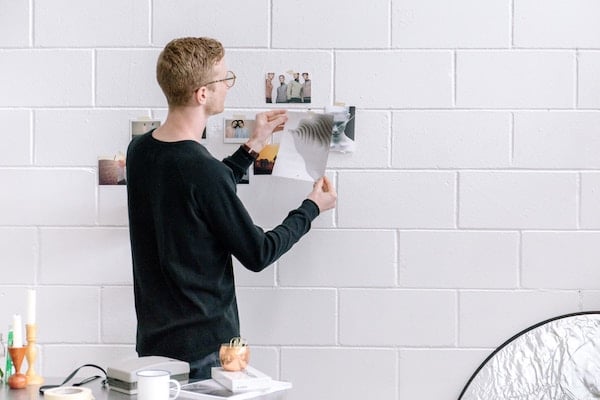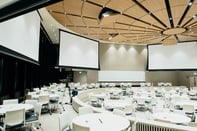Published on
Conscious Innovation: Setting a Future Path for Art and Design Colleges

How does an art and design college support a creative life?
Supporting a creative life is the ethical and moral duty of every art and design college. The days of the starving artist are long over. Institutions that directly or indirectly promote ideas of starving and sacrifice as professional necessities or inevitabilities are doing a great disservice to all artists and designers. Supporting a creative life is more than a job—it is the education and facilitation of the creative journey. Our graduates are not sacrificing anything, but like any other graduate of a higher education institution, are thriving and searching for all the same things.
In 1970, a group of artists witnessed safe and socially detached discussions of art and design taking place in classrooms across the world. In this environment, students were made to copy their instructor’s work, and not encouraged to create their own vision. In response to this unacceptable situation, they founded Montserrat College of Art. They embraced the need to experiment and disrupt the status quo in order to foster the innovation and evolution of all creative disciplines. In many ways, art and design schools are at that point again.
Dr. Martin Luther King, Jr. described the necessity for challenging the status quo:
“One of the great liabilities of history is that all too many people fail to remain awake through great periods of social change. Every society has its protectors of status quo and its fraternities of the indifferent who are notorious for sleeping through revolutions. Today, our very survival depends on our ability to stay awake, to adjust to new ideas, to remain vigilant and to face the challenge of change.”
We must recommit ourselves to the ideals of challenging the status quo, staying awake and disrupting whenever possible.
Colleges of art and design are centers of research and experimentation. Black Mountain College in the 1960s and the FLUXUS movement showed us the great influence research and experimentation have on our world and that they have a place in the halls of art and design colleges.
I want to talk about disruption a little more in the context of what I see as a primary purpose of art and design education.
In Jo Morrison’s 2013 article Disruption: Art and Design Higher Education Futures, the writer puts forth the following:
“‘How might Art and Design higher education take place when all information has been dematerialized into a distributed and networked virtual global environment?’ or, ‘what are the preferential future scenarios for art and design education in a world rich with intelligent and connected objects?’ (Today’s students will help to design and make these possible futures).”
I believe that higher education generally has become mind-numbingly boring. We have created pockets of innovation and creativity—and for those colleges doing that regularly I say THANK YOU!
Unfortunately, I have seen the industry of higher education playing it safe and not promoting free thinking and inquiry. Playing it safe and concentrating on general conformity has seeped into the ivy-covered walls of our campuses.
Truly committed leaders in art and design education do not allow the status quo of “playing it safe” to exist. Nor does the current higher education financial environment. We adapt because the world around us is constantly changing. We need to pivot so the next generation of creatives will challenge that next status quo. We need to facilitate real academic research and experimentation, on our own terms as art and design colleges. We need to diversify our making traditions on campus and through that action facilitate international dialogue dedicated to the influence of difference in ourselves as creative people.
Creativity is stifled by fear, public opinion, and the limits placed upon us by others and by ourselves. So, our faculty, staff and students need to be curious and be brave.
Jack Gilbert, a poet and professor, used to ask his students, “Do you have the courage to bring forth the treasures hidden within you?”
I don’t see that as an individual responsibility. One thing I have learned over the course of my career is that our collective art and design communities help us all bring out our hidden treasures by focusing the students on how to be curious and be brave.
We are a small college with a global reach, serving a transformational purpose in art and design education that only a small college can. No one gets lost here. What’s more, we have done the impossible and made what we do financially sustainable while establishing a curriculum that supports a creative life.
I believe it appropriate to end with the following reflection, based on the quote that greeted me on the Foyer wall of Syracuse University’s Maxwell School of Citizenship and Public Affairsas a graduate student. It’s an excerpt from the Athenian City-State Oath:
“We will ever strive for the ideals and sacred things of the city, both alone and with many; We will unceasingly seek to quicken the sense of public duty; We will revere and obey the city’s laws; We will transmit this city not only not less, but greater, better and more beautiful than it was transmitted to us.”
Art and design changes the world every day. It makes our lives richer by challenging the status quo, disrupting our accepted point of view and understanding our surroundings. I am dedicated to this important creative education because it makes the world greater, better and more beautiful than it was transmitted to us.
Art and design colleges need to be ready for the next transformation, the next revolution, our collective future. Our sector will lead, we will question, we will experiment, we will critique, we will offer solutions, we will break things, and we will dream of a past, sleep in the future, envision what we want the world to be.
Greatness is there for those who work hard and dream big. Greatness is our aspiration. Our community of artists, designers and artist educators are ready.
Author Perspective: Administrator



